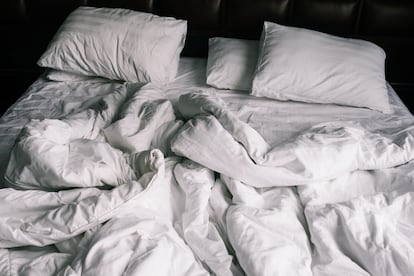This is what happens to your skin if you don’t wash your pillow
A dirty pillow is like a den of dust, sweat, grease, dead skin and bacteria that damages skin and hair. Experts explain why and how to wash it

A lot has been said about the importance of going to bed with well-cleansed and moisturized skin to get the most out of the period when cell regeneration occurs, but there is little point slipping into bed after a full beauty routine if your pillow is dirty. If you think that changing the bed linen once a week is enough to ensure you sleep on a clean surface, we regret to tell you that, according to the experts, you are mistaken. Let’s take it one step at a time. “You should change your pillowcase at least every two days. Although at first it may seem unimportant, throughout the night, the facial skin is in contact with it and it ends up becoming a deposit of bacteria that causes blackheads and pimples on the skin,” says Estefania Nieto, technical director of Omorovicza. However, your pillowcase is not the only thing that should be washed. Because experts agree that the pillow also needs frequent cleaning because it accumulates dust, sweat, grease, saliva, dead skin and other bacteria that affect the condition of the skin and hair. According to the study on ‘Habits, attitudes and beliefs about cleanliness and well-being in Spanish households’ conducted by Vorwerk, manufacturer of Thermomix and Kobold cleaning systems, ceilings (79%) and mattresses (68%) are the surfaces that are most rarely or never cleaned. This is without mentioning pillows, one of the most neglected surfaces in terms of cleaning.
“It is recommendable to wash pillows once or twice a year. Over time, they accumulate traces of sweat, sebum and dead skin cells, as well as microorganisms like bacteria and dust mites, which is why they should be washed, not just the pillowcases. The frequency depends on how dirty they get, how often the covers are washed and whether the person is allergic, especially to dust mites. But proper hygiene helps prevent skin problems and allergic reactions. It is also wise to go to bed with a clean face and hair. We must wash our skin with products that respect its pH and do not cause irritation because we can cause the opposite effect and disrupt the skin barrier with excessive or inadequate hygiene. Regarding the frequency of hair washing, this will depend on the person, the activity they do and whether they have more or less seborrhoea,” Dr. Almudena Nuño, member of the Aesthetic and Therapeutic Dermatology Group (GEDET) of the Spanish Academy of Dermatology and Venereology (AEDV), explains to S Moda.
We spend a third of the day with our face pressed against our pillow, and its condition not only affects our beauty. “Normal skin has a protective barrier function that, when in good condition, protects us from contact with bacteria. But if the dermis is sensitive or acne-prone, the presence of these microorganisms exacerbates its condition, because this type of skin has an altered barrier function. In these cases, the presence of dirt, bacteria and dust mites in the pillows causes inflammation and aggravates their pathology,” points out Dr. Nuño. Something similar happens in the hair “The pillow accumulates oils, products, sebum and pollution that are passed on to the hair and scalp. As a result, hair follicles can become clogged, hair grows weaker, becomes dull, opaque, brittle and can fall out. Also, the scalp can become itchy or irritated because the dirt is a breeding ground for fungi and bacteria. That is why it is necessary to wash the pillow regularly if we want to maintain healthy hair,” says Conchi Arias, founder of Campos Curlyhair.
That is not all, the presence of dust aggravates allergies and makes breathing more difficult. Dr. Almudena Nuño is clear about this: “Mites are common microorganisms that feed on human skin scales and accumulate in warm, moist locations, such as pillows. These tiny arthropods can trigger allergies that manifest in sneezing, itchy eyes, nasal congestion and wheezing. To reduce the presence of dust mites in pillows, it is important to wash them regularly at high temperature. I also recommend using hypoallergenic covers, as they create a physical barrier that helps to prevent the accumulation of dust mites and allergens in the interior.”
How often and how should we wash our pillow?
This is the million-dollar question, because before undertaking the task, several aspects must be taken into account. Washing the pillowcase is not the same as washing the inside part, and each type of pillow requires a different washing method. In terms of washing frequency “if we use a protective cover we can prolong it a little more, but ideally we should wash the pillow every two or three months, as long as we clean the dust once a week and there are no stains. As a minimum, it should be cleaned two or three times a year. To do this, the first thing we have to look at is whether the pillow is machine washable or not. If it is machine washable, always use a delicate program. And it is very important to compensate the load, in other words, it is better to put two pillows, one on each side, and not just one because it unbalances the drum and can damage the appliance. We can also compensate the load by putting in tennis balls. If it is not suitable for the washing machine, we will have to clean it with a damp cloth and our regular detergent, rubbing gradually over the entire surface,” says Paula Saiton, tidying and cleaning expert and creator of the Instagram account @paula.unsitioparacadacosa which has more than 300,000 followers.
Saiton advises basic care to ensure that the pillow remains in perfect condition for a long time. “There is one thing we hardly ever do and that is to read the manufacturer’s recommendations. This will give us the means to extend its lifespan and conserve it better. I always recommend using a protective cover, washing it two or three times a year and, if it gets stained, removing the stain as quickly as possible. It is best to lay it flat to dry as soon as possible.” It should be taken into account that pillows become very heavy when wet, so whenever possible it is preferable to wash them by hand.
Down or feather pillows: avoid deformation and mildew
Many feather and down pillows specify that they should be dry-cleaned. If that is the case, it is best to do so because both contain natural oils that cleaning products and high temperatures break down and leave pillows lumpy, deformed and difficult to fluff. If the label indicates ‘hand wash’ it is best to wash with warm water and add half a cup of vinegar to protect the fibers from mildew or bacteria. “If the label says it can be machine washed, we should use a delicate program and ensure that the load is homogeneous. If you have a top-load washing machine, it is best to place them vertically, to prevent pillows from piling up and deforming. When drying, it is best to lay it horizontally and gradually fluff the feathers. It can also be tumble dried at a low temperature,” Paula Saiton specifies.
Foam and viscoelastic: neither washing machine nor tumble dryer
One thing is unanimous: foam pillows and viscoelastic pillows cannot be put in the washing machine or dryer. Tumbling degrades the material, alters its shape and breaks the cushioning. For this reason, most of these pillows come with a fabric cover that can be washed following the instructions. So it is best to clean them the old-fashioned way: “We start by vacuuming the dust and mites and then cleaning by hand with a cloth dampened with warm water and the regular detergent. Rinse with another damp cloth and try to air dry them as soon as possible,” says the expert, Paula Saiton.
Fiberfill: machine washable, but with care
Pillows filled with synthetic polyester fibers are the easiest to be put in the washing machine and dryer. Paula Saiton emphatically says that: “You should wash two at a time (to balance the load) and use a high temperature program to eliminate dust mites and bacteria (between 40 and 60 degrees). We can also run a second rinse cycle to remove any remaining detergent and spin dry without using high revolutions, 800 rpm is sufficient. Then, we put it in the dryer at low temperature until the pillow is completely dry.”
What to do with stains and yellow pillows
To clean pillows it is recommendable to use natural products to prevent irritation due to the use of chemicals. “For sweat and saliva stains, it is best to use a mixture of baking soda, vinegar and a dash of liquid detergent, the one we usually use. This mixture should be left to act on the stains for 10 to 20 minutes and then rub with a small brush until it disappears. Rinse and dry. If the pillow is yellowish, we can add half a cup of percarbonate to our wash, because at high temperatures it helps to obtain the desired whitening,” says Saiton.
When is it time to change your pillow?
At some point it is wise to stop washing them and get rid of them. So when should we buy a new one? For experts there is a quick and easy hack. Fold the pillow in half and if it does not regain its original shape, it’s time to throw it away. It is also recommendable to change your pillow as soon as you detect the slightest musty odor.
Sign up for our weekly newsletter to get more English-language news coverage from EL PAÍS USA Edition
Tu suscripción se está usando en otro dispositivo
¿Quieres añadir otro usuario a tu suscripción?
Si continúas leyendo en este dispositivo, no se podrá leer en el otro.
FlechaTu suscripción se está usando en otro dispositivo y solo puedes acceder a EL PAÍS desde un dispositivo a la vez.
Si quieres compartir tu cuenta, cambia tu suscripción a la modalidad Premium, así podrás añadir otro usuario. Cada uno accederá con su propia cuenta de email, lo que os permitirá personalizar vuestra experiencia en EL PAÍS.
¿Tienes una suscripción de empresa? Accede aquí para contratar más cuentas.
En el caso de no saber quién está usando tu cuenta, te recomendamos cambiar tu contraseña aquí.
Si decides continuar compartiendo tu cuenta, este mensaje se mostrará en tu dispositivo y en el de la otra persona que está usando tu cuenta de forma indefinida, afectando a tu experiencia de lectura. Puedes consultar aquí los términos y condiciones de la suscripción digital.
More information
Últimas noticias
Most viewed
- Sinaloa Cartel war is taking its toll on Los Chapitos
- Oona Chaplin: ‘I told James Cameron that I was living in a treehouse and starting a permaculture project with a friend’
- Reinhard Genzel, Nobel laureate in physics: ‘One-minute videos will never give you the truth’
- Why the price of coffee has skyrocketed: from Brazilian plantations to specialty coffee houses
- Silver prices are going crazy: This is what’s fueling the rally










































